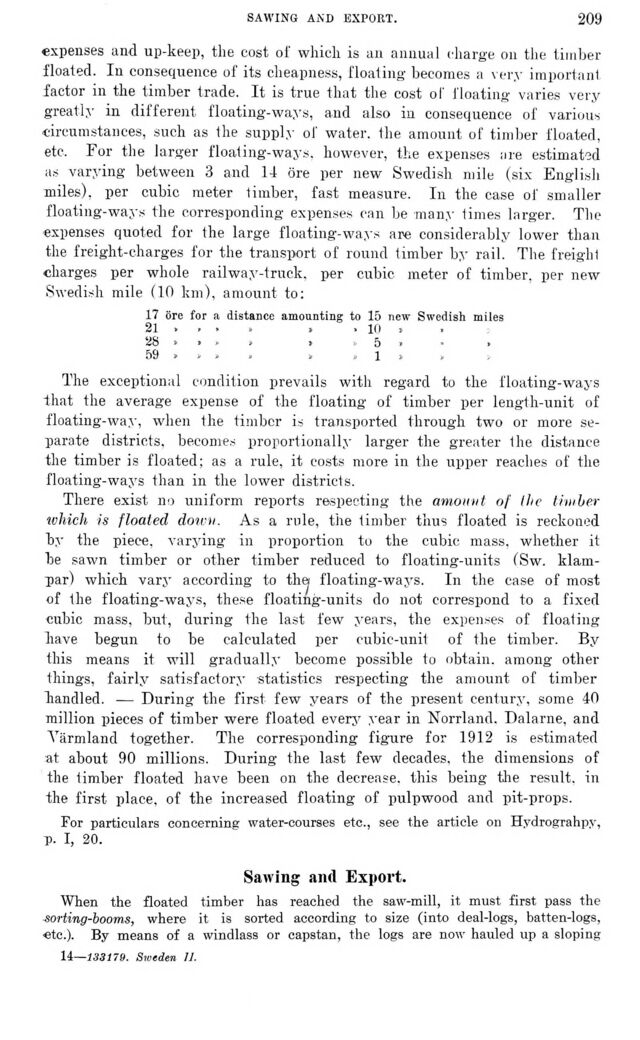
Full resolution (JPEG) - On this page / på denna sida - IV. Forestry - 2. Forest Industries. By E. Arosenius - Floating. By Th. Örtenblad

<< prev. page << föreg. sida << >> nästa sida >> next page >>
Below is the raw OCR text
from the above scanned image.
Do you see an error? Proofread the page now!
Här nedan syns maskintolkade texten från faksimilbilden ovan.
Ser du något fel? Korrekturläs sidan nu!
This page has never been proofread. / Denna sida har aldrig korrekturlästs.
sawing and export.
209
expenses and up-keep, the cost of which is an annual charge 011 the timber
floated. In consequence of its cheapness, floating becomes a very important
factor in the timber trade. It is true that the cost of floating varies very
greatly in different floating-ways, and also in consequence of various
circumstances, such as the supply of water, the amount of timber floated,
etc. For the larger floating-ways, however, the expenses are estimated
as varying between 3 and 14 ore per new Swedish mile (six English
miles), per cubic meter timber, fast measure. In the case of smaller
floating-ways the corresponding expenses can be many times larger. The
expenses quoted for the large floating-ways are considerably lower than
the freight-charges for the transport of round timber by rail. The freight
charges per whole railway-truck, per cubic meter of timber, per new
Swedish mile (10 km), amount to:
17 ore for a distance amounting to 15 new Swedish miles
21 ... » » • 10 >
28 » » > . > 5 »
59 » » » v » > .
The exceptional condition prevails with regard to the floating-ways
that the average expense of the floating of timber per length-unit of
floating-way, when the timber is transported through two or more
separate districts, becomes proportionally larger the greater the distance
the timber is floated: as a rule, it costs more in the upper reaches of the
floating-ways than in the lower districts.
There exist no uniform reports respecting the amount of the timber
which is floated down. As a rule, the timber thus floated is reckoned
by the piece, varying in proportion to the cubic mass, whether it
be sawn timber or other timber reduced to floating-units (Sw.
klam-par) which vary according to th a floating-ways. In the case of most
of the floating-ways, these floating-units do not correspond to a fixed
cubic mass, but, during the last few years, the expenses of floating
liave begun to be calculated per cubic-unit of the timber. By
this means it will gradually become possible to obtain, among other
things, fairly satisfactory statistics respecting the amount of timber
bandied. — During the first few years of the present century, some 40
million pieces of timber were floated every year in Norrland. Dalarne, and
Yärmland together. The corresponding figure for 1912 is estimated
at about 90 millions. During the last few decades, the dimensions of
the timber floated have been on the decrease, this being the result, in
the first place, of the increased floating of pulpwood and pit-props.
For particulars concerning water-courses etc., see the article 011 Hydrograhpy,
p>. I, 20.
Sawing and Export.
When the floated timber has reached the saw-mill, it must first pass the
sorting-booms, where it is sorted according to size (into deal-logs, batten-logs,
etc.). By means of a windlass or capstan, the logs are now hauled up a sloping
14—133179. Sweden 11.
<< prev. page << föreg. sida << >> nästa sida >> next page >>